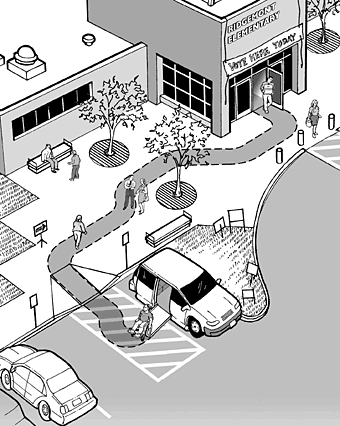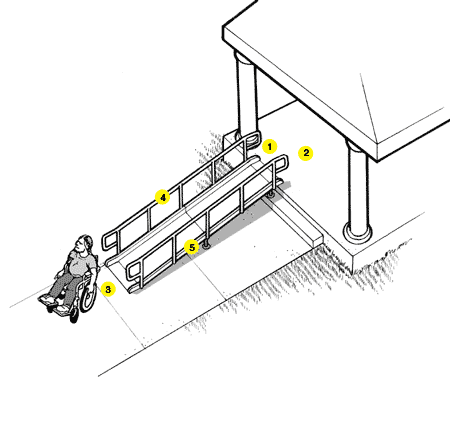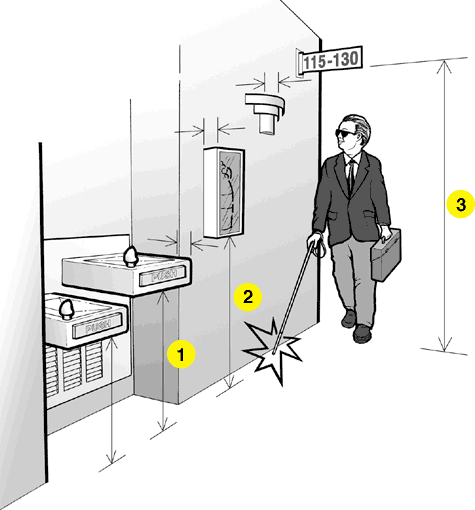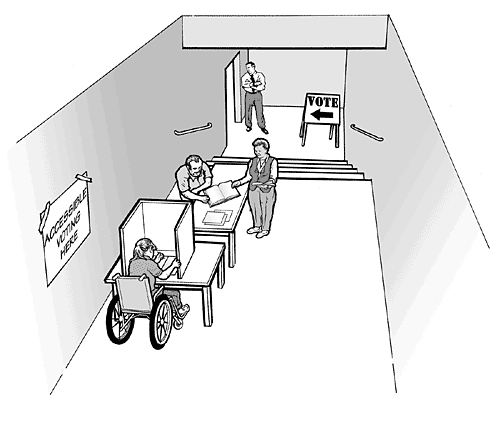Are your polling/voting places accessible?
Posted on - Monday, May 21st, 2012I live in Texas and have been following the Republican primary in other states. Now that the primaries are coming to our State I was informed by a very good interior designer and friend of mine (who shall remain nameless to protect her identity) that there are several polling centers that are not accessible. Even though the polling centers are only temporary, they are providing a “government program” which has to be made accessible. When someone votes, the service that the government is providing must be equal and available to everyone, including persons with disabilities.
This is what she wrote me:
“I have voted early for years to avoid the crowds. Yesterday and going back 6 years, I voted at polling sites where I have observed questionable Accessibility setups. All the pollworkers are volunteers (I think) who set up whatever space is given to them with instructions that are unknown to me. For two elections, I had absentee ballots so I do not know the conditions of the setup of voting tables, computer heights, etc. for those elections.
Six years ago, the voting was done at an elementary school on the auditorium stage accessed by about 6 or 8 steps. All the voting “booths” were stand up height and paper ballots were inserted into a counting machine. I am guessing that paper ballots were provided at the main floor level for wheelchair voters. Checking in for everyone was done at the main level where judges could assist voters.
Four years ago, at my local elementary school polling place, there were only the tall voting carrels separated from each other so there was some privacy provided by the distance between them. At that time, I asked why there was no H/C identifiable lower table for a wheelchair person to use. The poll worker was in a wheelchair and she pulled up to the high work surface and demonstrated how she could lift her arms to mark the ballot. Think bar height work surface being used from a seated chair height position.
Yesterday, at the polling place, all but two computer stations were located on 28″ high tables. The other two voting stations were the higher ones with no computers on them. I told the poll worker that I was concerned about the height of the machines for users, the H/C identified voting computer at the end of the table with the table leg in the way and did not go into the proximity of the stand up voting carrel to the tables with computers. The poll worker got his walker and we moved across the room to the area that I wanted to talk about. He had never heard of the ADA or TAS. The Dallas County Election Board is where they get their directives. Having been at the Dallas County Election Board as an observer of an election recount for a State Rep., I can assure you that the employees I met there likely have not heard of these regulations either. The poll worker explained to me that the computer with the H/C sign was for blind voters.
At that point, I just had to write to you to ask you to look at this photo and tell me what you see that I might have missed. I asked the poll worker to at least put the H/C sign on the computer in the center space. I felt it was futile to try to explain any more about having room under the table for the wheelchair and foot room.
This is Early Voting and Election Day is May 29th. I do not know if anything can be done prior to election day, but is there not a way to get RAS, architects and RID’s to look at their polling places to see if accomodations are being made?
Last time I mentioned this to my local precinct, the comments fell on deaf ears. When there is nothing in the poll worker’s experience that causes them to recognize any accessibility measure, then they just brush off my comments as complaints…and nothing gets done. “
My friend is right. Even though these are temporary places, they are still a voting place and will require some form of access. The voter who is disabled must be able to have the same privacy as everyone else. The voter who is disabled must have access to the same ballot and the same method of voting as everyone else. So how does a polling place provide this access? The ADA website has a pamphlet that they put out in 2004 that explains how to provide access even when the polling place is only temporary. The Election Assistance Commission has a video that is also helpful for polling places to provide access.
In a nutshell the following items need to be provided to the best of their ability, unless it is not feasible and then other accommodations should be provided to ensure that all voters, disabled or not, can cast their ballot:
1. Accessible parking or passenger drop off should be available
2. An Accessible route to the entrance
3. An accessible entrance to the voting site
4. A route free from hazards
5- Counter or table where the voting is taking place should be between 28″-34″ in height and a forward approach knee space should be provided
Everyone should go to their polling places and make sure there are facilities that are accessible for voters in wheelchairs, voters who are visually impaired as well as hearing impaired. Let’s try and make this election an accessible one.
 Abadi
Abadi 





